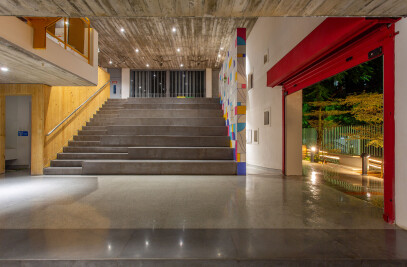The administrative office for the Metallic Bellows factory is located on a site of around 16,000 sqm at Vallam, Sriperumbudur. The proposed office is built to the north of the existing manufacturing factory facing the road. The single-story brick-covered structure has glazed office rooms adjacent to gardens with wide brick paved walkways connecting the various spaces.

This project's journey started as four-panel stories, which shaped the thinking of the design. In a documentary on BV Doshi, where he is at Sarkhej Roza in Ahmedabad, as Doshi walks through the spaces, he describes the beauty of the space through its quality of light, shadow, sense of transparency, and gradation of spaces. He also describes an inherent beauty in imperfection, a result of a hand-crafted building and its simplicity being a celebration of frugality. An edifice completely built and finished in a singular material. Is there an opportunity to approach a design from a mono-material perspective?

The second story that influenced the design is about one of the visits to the client’s existing facility, a small production unit situated in a congested part of the city. Lots of plants, succulents, cacti, and exotic varieties filled all the site margins and gaps between the production sheds. How can we efficiently preserve them and also make them an integral part of the design?

When we visited the new development, we passed by quite a few brick kilns. The local soil is clayey in nature, which is ideal for brickmaking. Clay brick, which was available locally as a material, lent a sense of warmth to the space, a connection to the soil that resonated with our thinking. Could brick be our mono material of choice?

The initial thought was to create a series of gardens and courtyards spread across the ground, creating a path and an experience that would allow the user to move, pause, and enjoy this journey through space. The path within the garden was then defined by a series of coerced verandas, which straddle the notion of being considered partly indoors or partly outdoors.

The program was then formalized in the form of rooms alongside these verandahs to guide and steer the various views and experiences. With the aim to reduce the amount of concrete being used, the first thought came towards using brick for walls, floors, and roofs as well. Brick has an impression of being very heavy and solid. The traditional system of Jack arch (a tried and tested, mortar-less shallow arch system) with downstand beams and peripheral beams is used to make brick feel lighter, seeming to float over a space as brick has the impression of being heavy and solid.
In a conventional jack arch system, the secondary beams are designed as downstand elements and feel heavy. Pushing the beam up into the rise of the arch creates a flat surface where the arch begins to spring. This now allows the brick arches to float over the structure, leading to a sense of lightness in the space under it. 23 bricks were used for the jack arch after many trials in order to optimize the number of bricks. These bricks are locally sourced and cost around 10 cents a brick.

Insulating the building is very important to keep the heat out of the buildings in the tropics. To reduce the heat gain, the space above the jack arches between the upstand beams has been filled with lightweight filling material to provide a flat top surface. This overall assembly of materials and their thickness has greatly reduced the thermal heat gain from the roof, which in turn has reduced the load on the air conditioning system. The shaded glass surfaces and the cavity walls further reduce the heat load on the interiors, and the glare-free light and views can be enjoyed without the need for any window covering. For 6 months in a year when the weather is a little better, there is no need to run any form of air-conditioning, allowing the building envelope and the gentle breeze to keep the spaces cool.

The usage of bricks, primarily in the roof structure, has not only insulated the building and reduced the load on mechanical cooling but also reduced the usage of concrete as a roof element. Brick, when compared to cement in concrete, can reduce CO2 emissions by up to 70%, resulting in an overall CO2 reduction of around 50 tons.















































